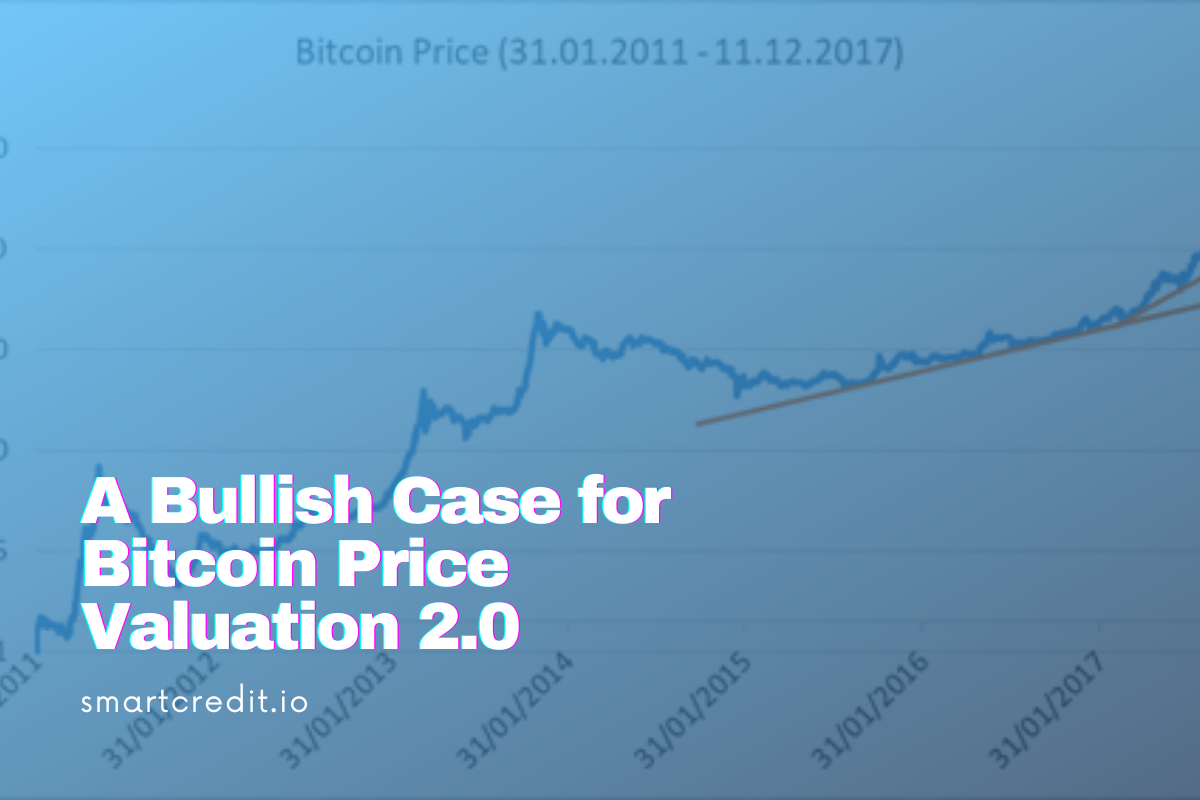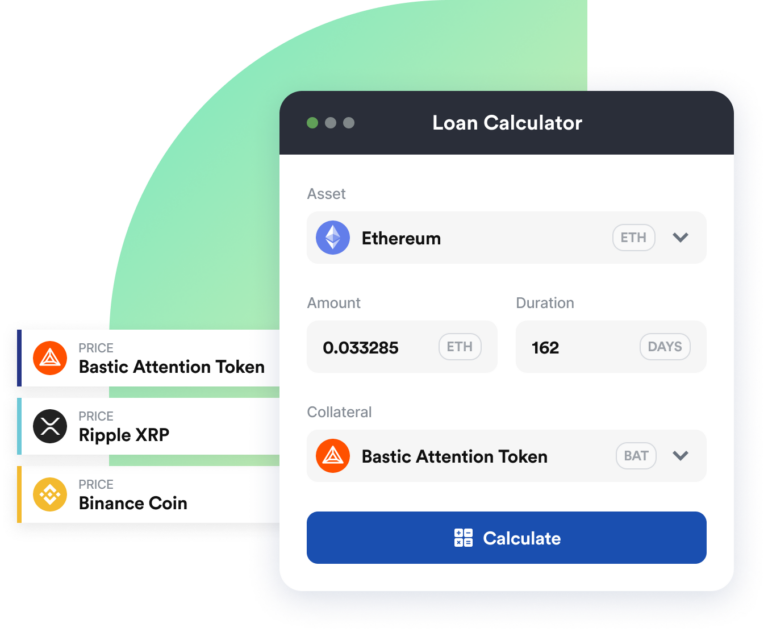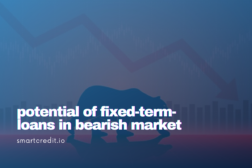How much should be the Bitcoin price? In January 2014 we forecasted the Bitcoin price valuation of 10’000 USD in the Swiss CFA Charter Magazine. The Bitcoin price reached a record high of $19,850 in December 2017. Given the hype surrounding the value of Bitcoin, what could we expect Bitcoin price to be in the future?
The Bitcoin price can be derived from the following:
- The store of value, like gold and other real assets
- Means of payment
- (Future) provider of smart contracts platform for disintermediation of today’s big corporations.
Bitcoin Price Development
The following graph shows the Bitcoin price on a logarithmic scale – we see exponential Bitcoin price development. We see as well, that it’s moving too fast up, so the correction is expected in the next months.
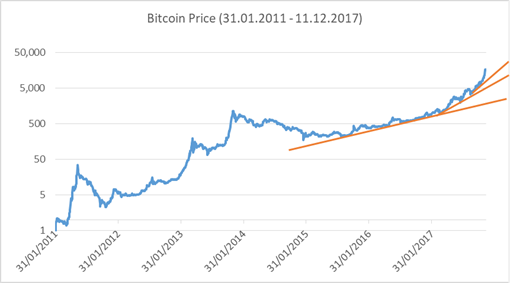
Number of Users in Crypto Sphere
Most users of Bitcoin will use the currency through the use of an ‘internal blockchain wallet” on the Exchange (e.g. Bitfinex, Bitstamp, Coinbase, etc.) rather than an “external bitcoin wallet” in the blockchain. After getting more experienced in Crypto, we expect these users will create their wallets on the public Bitcoin blockchain. In this situation, they will be real owners of their Bitcoins (as opposed to having a claim with the Exchange who owns the private keys for the Bitcoins).
There are no user numbers available for Bitfinex which is the largest crypto exchange. However, data is available for Coinbase (also known as GDAX), which is the second-largest crypto exchange –. Coinbase is growing at the moment by 50’000–100’000 users per day. The following graph shows the number of Coinbase users. The graph is on a logarithmic scale and so the straight line shows exponential user growth:
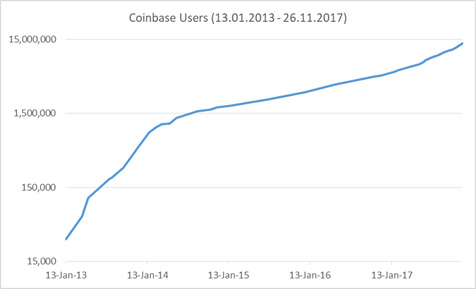
Coinbase trades 10% of the total global Bitcoin volume and there are over one hundred exchanges. If Coinbase is growing 50–100,000 users per day and blockchain.info by 50–80,000 users per day, then we estimate conservatively daily growth rate of 200,000–300,000 users per day (users usually register not only on one exchange but multiple exchanges).
We estimate approximately 20 million direct users of Bitcoin blockchain and an additional 15 million users who use Bitcoin through their exchange wallets. Not all of these users own Bitcoins many of them have moved into other cryptocurrencies. Many of the users own more than one address as well and we estimate 35 million active cryptocurrency users at the moment.
Transaction Volume
On 11.12.2017 there were approximately 400’000 transactions on the network and the total transaction value was 4.3 Billion USD. The following graph shows transaction volume on a logarithmic scale and exponential growth
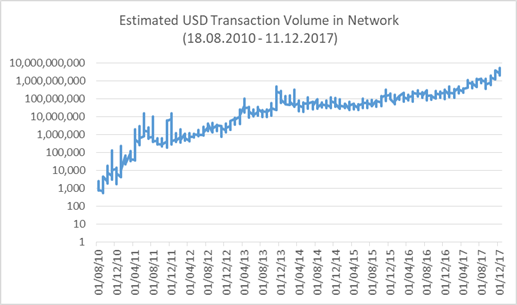
Network Effect
One can see exponential growth in Bitcoin Price, in the number of Bitcoin users, and the transaction value over the Bitcoin blockchain.
To consider how to translate the growth into Bitcoin value, I consider the application of Metcalfe’s law, which states that the value of the network is not growing linearly but to the square of the number of users. The number of users has been growing more than two times every year. Currently, the network grows by 200,000–300,000 users per day. If we assume doubling the number of users of Bitcoin per year, this translates into value growth of two and four times.
Many cryptocurrency platforms (like Bitcoin and others) are instances of the “network economy”. These are not like traditional companies that grow through scale but where the value is linear to capital used. The network economy value is not driven by capital used and by scale effects but rather two parameters:
- Number of users
- Number of transfers/ relations/transactions between the users
Number of transactions
Bitcoin network received major re-design in August this year when the so-called SegWit protocol was initialized. The next step is to initialize the Lightning Network protocol. These protocols increase the throughput of the network by introducing “two-layer” transactions. There are transactions on the main blockchain and light transactions settled later on the main network. This will lead to a massive increase in transactions on the Bitcoin network because current transaction fees which can exceed 50 USD are relatively expensive for users.
Adoption Curve
Every new technology such as fax, e-mail, internet, and even Bitcoin can follow the adoption curve. The following graph shows the Gauss bell-curve and the S-Curve, which both can be used for adaption.

Our analysis above estimates approximately 35 million active cryptocurrency users. The world population is 7.6 billion less young children, the elderly, and people in state institutions. And if we assume half of the world population would be potential Bitcoin users, this translates into a worldwide adaption rate of 1%.
However, we could expect most of the cryptocurrency users are in OECD countries and contribute to 80% of its use considering that 80% of the number of Bitcoin nodes are deployed in OECD countries. Given the OECD population is 1’154 million, from which the economically active population is 700–800 million people, the OECD adaption rate is 3.5%.
This implies that the Bitcoin network has entered the early adopter’s phase on the S-Curve in OECD countries. This phase will be characterized by the development of real-world business use cases, by emerging “killer apps” and by increasing the rate of adoption.
Value Adding Services on the Bitcoin Network
Bitcoin is a highly secure network, but it does not support “smart contracts”, which are supported by about ten different crypto-platforms. Smart contracts allow us to build value-adding business applications on top of the crypto-platforms and generate additional usage on the platform. This translates into higher valuation given the value of the network depends on the number of nodes and the number of transactions on the network. For example, the Ethereum platform has thousands of so-called “decentral apps” which are often financed through Initial Coin Offerings — ICO’s.
However, through emerging sidechain technology it will become possible to connect Bitcoin with Smart Contract platforms such as the “Rootstock project”. This would build “decentral apps” which are connected to Bitcoin blockchain security and translate into a higher number of transactions on the network and higher value.
The Coordination Problem in Economy
“Decentral apps” offer the potential to build new business models through disintermediation. Today’s big corporations, which enjoy oligopoly or monopoly positions have been built through solving the coordination problem with hierarchical and process-based methods rather than through a market mechanism outside of the banks.
If one is dealing with digital goods, like in banking, media, or insurance sectors, and if coordination mechanisms can be solved through blockchain and decentral app-based marketplaces, then the need for big corporations, as we know them today, will reduce.
Adam Smiths’ “Wealth of Nations” describes the model of free-market capitalism but was based on companies that would today classify as small companies. However, the coordination problem led to the emergence of large corporations, and through their oligopoly and monopoly market positions have moved away from the concept of free-market capitalism as defined by Adam Smith.
Disintermediation of centralized business models through blockchain and decentral apps will lead to significant value creation in new business models and at the same time to value the destruction of today’s big corporations.
Bitcoin Price Estimation
We consider the valuation has three components:
Network value as a store of value
The number of Bitcoin users doubles every year and if we take the base price in 2017 at approximately 1’000 USD, then the price by the end of 2018 should be 2’000 and 4’000 USD.
The current price is higher and will lead to a short-term correction over the coming months. However, by taking 3’000 USD as the current fair price and projecting exponential growth of the network, the price in four years would be expected to be between 50’000 and 750’000 USD.
Network value based on the possibility to execute transactions between the users
The Bitcoin network has reached its current throughput limits. However full implementation of Segwit and Lightning protocols will lead to massive enablement of the smaller transactions on the network, which will increase the network’s value.
This allows us to adjust the forecasted price in four years from 50’000 to 80’000 USD.
Network value through value-adding services on Bitcoin Network
The Internet boom beginning of this century focused first on technology (telecoms, broadband, etc.) and then emerging companies such as Facebook, Google, and Amazon. The same trend is happening in the crypto-sphere. The current focus on underlying technologies will shift to network-based business models, which will result in newly created applications and lead to the major adoption of the platform.
Bitcoin enrichment with Smart Contract functionality facilitates further applications and will translate into additional Bitcoin network value increase at the same time.
This allows further adjustment of the Bitcoin price forecast in four years to 80’000 to 100’000 USD.
Summary
Blockchain technologies, which were first implemented with Bitcoin, will enable the “Cambrian explosion” of new blockchain-based business models, which started with simple use cases like “store of value” and “payment”. Adding “disintermediation” models allow real blockchain-based killer-apps, and a networked economy based business models. Bitcoin network will be the key beneficiary of this upcoming “Cambrian explosion“.
Our forecast four years ago was that the Bitcoin price will be 10’000 USD. Our new conservative forecast will be that the Bitcoin price will reach 100’000 USD in the next four years.
